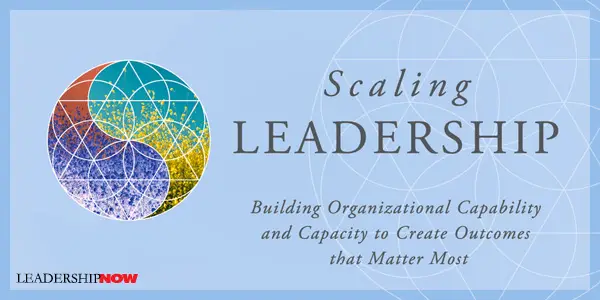 |
 |
02.06.19

Scaling Leadership
THE INEVITABLE CONSEQUENCE of leading in an increasingly complex world is that we will have developmental gaps in our leadership. As our context change, we have to grow with it. In the words of Robert Anderson and William Adams, authors of Scaling Leadership, “We are running an Internal Operating System that is not complex enough for the complexity we face. This is our Development Gap.” We are often pushed to our limits. The solution is to scale our leadership. Leadership must learn to scale itself, but not any kind of leadership will do. We need much more of the kind of leadership that is capable of scaling innovation, adaptability, sustainability, agility, and engagement as its growth strategy. Scaling leadership is about becoming the kind of leader that scales the conscious leadership capable of creating what matters most of all the stakeholders it serves. So just what is this “conscious leadership?” To answer this question, they asked 50,000 leaders and employees worldwide, “What kind of leadership, if it existed, would enable the organization to thrive in its current marketplace and into the future?” The answer is displayed in the Optimal Leadership Circle Profile below. The top half of the circle are the 18 Creative Competencies that lead to leadership effectiveness. The bottom half is comprised of 11 Reactive Tendencies. These are our go-to strengths and behaviors we rely on when we feel under pressure. The reactive tendencies often get the job done but at a cost—disenchanted and disengaged employees and stakeholders that feel bullied or let down.
In order to scale your leadership, the right conditions must exist. First and foremost, we have to consciously move our leadership from reactive to creative. Also a Generative Tension or Strategic Intent must exist as leaders take responsibility for and establish a development agenda for themselves and their organization. Finally, as represented by the top half of the inner circle, four more conditions must exist: Relating or Deep Relationship, Self-Awareness, and Authenticity or Radically Human, Systems Awareness or Big Picture, and Achieving or Purposeful Achievement. How do you show up as a leader? Creative? Reactive? In their study, High-Creative leaders consistently demonstrated the following 10 strengths. Interestingly, the first four represent the areas with the highest leadership gaps—areas where leaders need the most work.
It’s not surprising that these were the most strongly endorsed strengths. People perform better when respected and your leadership is perceived as better when you are respectful. As Bill Adams father told him growing up, “How you get results is as important as the results themselves.” It’s easy to forget in a world where the end seems to justify the means. In the authors consulting work they have found that when leaders derail it’s because while they are very talented, they are highly reactive. They underuse their High-Creative strengths. Often what got them where they are, is no longer working in their new leadership context. Their research indicates areas that all leaders need to consider and develop where necessary. But of course, simply following a list is a bit simplistic. Or to say because I am relational, I’m a better leader. Because I’ve got good people skills, I’m naturally effective. We all come to leadership with strengths and weakness. Learning to honestly face where you need work and where you need to temper your strengths, is the sign of a great leader. Scaling leadership is a good place to begin the journey. In conclusion, the authors state that there’s more. Creative Leadership alone isn’t going to get the job done. “No matter how you cut it, we are up against a level of escalating complexity and disruptive change that requires, and will continue to require, an unprecedented level of innovation, adaptability, scalability, sustainability, resilience, collective intelligence, engagement, empowerment, agility, systemic thinking, and global cooperation.” What we need they term Integral Leadership “supported by a Self-Transforming Internal Operating System in some depth.” That’s to say we are no longer leading for ourselves but for a purpose larger than ourselves that comes through in everything we do. It means we go deeper to develop our character—who we are. We no longer sponsor change in the organization, we radically, humanly, and in deep relationship lead change from the perspective that the system is mirroring the function and dysfunction in us, individually and collectively. We project our shadow less and less, and therefore, we can engage conflict without reactively making the other into an enemy or adversary. We experience others as much like us, a work in progress, and we engage in dialogue from a place of listening, learning, compassion, and strength. Humility. Empathy. Faith. Grace. We are more alike than different. Integral leadership sees through our differences “to a deeper unity that we all share—that we all are. We are all each other.” You can learn more about the Leadership Circle Profile and take your free self-assessment on the Leadership Circle website. 
Posted by Michael McKinney at 12:16 AM
|
BUILD YOUR KNOWLEDGE
 

How to Do Your Start-Up Right STRAIGHT TALK FOR START-UPS 
Grow Your Leadership Skills NEW AND UPCOMING LEADERSHIP BOOKS 
Leadership Minute BITE-SIZE CONCEPTS YOU CAN CHEW ON 
Classic Leadership Books BOOKS TO READ BEFORE YOU LEAD |